
|

|
Ev ve Ofis taşıma sektöründe lider olmak.Teknolojiyi klrd takip ederek bunu müşteri menuniyeti amacı için kullanmak.Sektörde marka olmak.
İstanbul evden eve nakliyat
Misyonumuz sayesinde edindiğimiz müşteri memnuniyeti ve güven ile müşterilerimizin bizi tavsiye etmelerini sağlamak.
Age Classification Based on Gait Using HMM
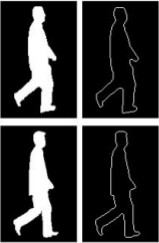 We have proposed a new framework for age
classification based on human gait using the Hidden
Markov Model (HMM). To extract
appropriate gait features, we consider a contour
related method in terms of shape variations during
human walking. Then the image feature is transformed
to a lower-dimensional space by using the Frame to
Exemplar (FED) distance. A HMM is trained on the
FED vector sequences. Thus, the framework provides
flexibility in the selection of gait feature representation.
In addition, the framework is robust for classification
due to the statistical nature of HMM. The experimental
results show that video-based automatic age
classification from human gait is feasible and reliable.
We have proposed a new framework for age
classification based on human gait using the Hidden
Markov Model (HMM). To extract
appropriate gait features, we consider a contour
related method in terms of shape variations during
human walking. Then the image feature is transformed
to a lower-dimensional space by using the Frame to
Exemplar (FED) distance. A HMM is trained on the
FED vector sequences. Thus, the framework provides
flexibility in the selection of gait feature representation.
In addition, the framework is robust for classification
due to the statistical nature of HMM. The experimental
results show that video-based automatic age
classification from human gait is feasible and reliable.
Ethnicity Classification Based on Gait Using Multi-view Fusion
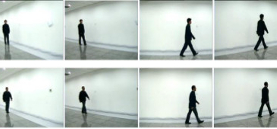 The determination of ethnicity of an individual, as a soft
biometrics, can be very useful in a video-based surveillance
system. Currently, face is commonly used to determine the
ethnicity of a person. Up to now, gait has been used for
individual recognition and gender classification but not for
ethnicity determination. Gait Energy
Image (GEI) is used in this research to analyze the recognition power
of gait for ethnicity. Feature fusion, score fusion and decision
fusion from multiple views of gait are explored. For
the feature fusion, GEI images and camera views are put
together to render a third-order tensor (x; y; view). A multilinear
principal component analysis (MPCA) is used to extract
features from tensor objects which integrate all views.
For the score fusion, the similarity scores measured from
single views are combined with a weighted SUM rule. For
the decision fusion, ethnicity classification is realized on
each individual view first. The classification results are then
combined to make the final determination with a majority
vote rule. A database of 36 walking people (East Asian
and South American) was acquired from 7 different camera
views. The experimental results show that ethnicity can
be determined from human gait in video automatically. The
classification rate is improved by fusing multiple camera
views and a comparison among different fusion schemes
shows that the MPCA based feature fusion performs the
best.
The determination of ethnicity of an individual, as a soft
biometrics, can be very useful in a video-based surveillance
system. Currently, face is commonly used to determine the
ethnicity of a person. Up to now, gait has been used for
individual recognition and gender classification but not for
ethnicity determination. Gait Energy
Image (GEI) is used in this research to analyze the recognition power
of gait for ethnicity. Feature fusion, score fusion and decision
fusion from multiple views of gait are explored. For
the feature fusion, GEI images and camera views are put
together to render a third-order tensor (x; y; view). A multilinear
principal component analysis (MPCA) is used to extract
features from tensor objects which integrate all views.
For the score fusion, the similarity scores measured from
single views are combined with a weighted SUM rule. For
the decision fusion, ethnicity classification is realized on
each individual view first. The classification results are then
combined to make the final determination with a majority
vote rule. A database of 36 walking people (East Asian
and South American) was acquired from 7 different camera
views. The experimental results show that ethnicity can
be determined from human gait in video automatically. The
classification rate is improved by fusing multiple camera
views and a comparison among different fusion schemes
shows that the MPCA based feature fusion performs the
best.
Human recognition in a video network
.png) Video networks is an emerging interdisciplinary field with significant and exciting scientific and technological challenges. It has great promise in solving many real-world problems and enabling a broad range of applications, including smart homes, video surveillance, environment and traffic monitoring, elderly care, intelligent environments, and entertainment in public and private spaces. This paper provides an overview of the design of a wireless video network as an experimental environment, camera selection, hand-off and control, anomaly detection. It addresses challenging questions for individual identification using gait and face at a distance and present new techniques and their comparison for robust identification.
Video networks is an emerging interdisciplinary field with significant and exciting scientific and technological challenges. It has great promise in solving many real-world problems and enabling a broad range of applications, including smart homes, video surveillance, environment and traffic monitoring, elderly care, intelligent environments, and entertainment in public and private spaces. This paper provides an overview of the design of a wireless video network as an experimental environment, camera selection, hand-off and control, anomaly detection. It addresses challenging questions for individual identification using gait and face at a distance and present new techniques and their comparison for robust identification.
Recognition of Walking Humans in 3D: Initial Result
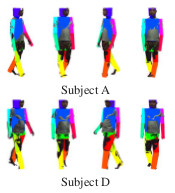 It has been challenging to recognize walking humans
at arbitrary poses from a single or small number of video
cameras. Attempts have been made mostly using a 2D
image/silhouette-based representation and a limited use of
3D kinematic model-based approaches. Unlike all the previous work in computer vision
and pattern recognition, the models of walking humans
are built using the sensed 3D range data at selected poses
without any markers. An instance of a walking individual
at a different pose is recognized using the 3D range data of
that pose. Both modeling and recognition of an individual
are done using the dense 3D range data. The proposed approach
first measures 3D human body data that consists of
the representative poses during a gait cycle. Next, a 3D human
body model is fitted to the body data using an approach
that overcomes the inherent gaps in the data and estimates
the body pose with high accuracy. A gait sequence is synthesized
by interpolation of joint positions and their movements
from the fitted body models. Both dynamic and static
gait features are obtained which are used to define a similarity
measure for an individual recognition in the database.
The experimental results show high recognition rates using
our range based 3D gait database.
It has been challenging to recognize walking humans
at arbitrary poses from a single or small number of video
cameras. Attempts have been made mostly using a 2D
image/silhouette-based representation and a limited use of
3D kinematic model-based approaches. Unlike all the previous work in computer vision
and pattern recognition, the models of walking humans
are built using the sensed 3D range data at selected poses
without any markers. An instance of a walking individual
at a different pose is recognized using the 3D range data of
that pose. Both modeling and recognition of an individual
are done using the dense 3D range data. The proposed approach
first measures 3D human body data that consists of
the representative poses during a gait cycle. Next, a 3D human
body model is fitted to the body data using an approach
that overcomes the inherent gaps in the data and estimates
the body pose with high accuracy. A gait sequence is synthesized
by interpolation of joint positions and their movements
from the fitted body models. Both dynamic and static
gait features are obtained which are used to define a similarity
measure for an individual recognition in the database.
The experimental results show high recognition rates using
our range based 3D gait database.
Human Recognition at a Distance
.png) This paper consider face, side face, gait and ear and their possible fusion for human recognition. It presents an overview of some of the techniques that we have developed for (a) super-resoulution-based face recognition in video, (b) gait-based recognition in video, (c) fusion of super-resolved side face and gait in video, (d) ear recognition in color/range images, and (e) fusion performance prediction and validation. It presents various real-world examples to illustrate the ideas and points out the relative merits of the approaches that are discussed.
This paper consider face, side face, gait and ear and their possible fusion for human recognition. It presents an overview of some of the techniques that we have developed for (a) super-resoulution-based face recognition in video, (b) gait-based recognition in video, (c) fusion of super-resolved side face and gait in video, (d) ear recognition in color/range images, and (e) fusion performance prediction and validation. It presents various real-world examples to illustrate the ideas and points out the relative merits of the approaches that are discussed.
Feature fusion of side face and gait for video-based human identification
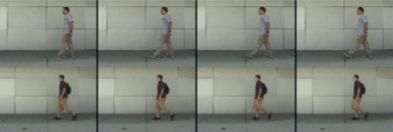 Video-based human recognition at a distance remains a challenging problem for the fusion of multimodal
biometrics. We present a
new approach that utilizes and integrates information from side face and gait at the feature level. The features of
face and gait are obtained separately using principal component analysis (PCA) from enhanced side face image
(ESFI) and gait energy image (GEI), respectively. Multiple discriminant analysis (MDA) is employed on the
concatenated features of face and gait to obtain discriminating synthetic features. The experimental results demonstrate that the synthetic features, encoding both side face and gait
information, carry more discriminating power than the individual biometrics features, and the proposed feature
level fusion scheme outperforms the match score level and another feature level fusion scheme.
Video-based human recognition at a distance remains a challenging problem for the fusion of multimodal
biometrics. We present a
new approach that utilizes and integrates information from side face and gait at the feature level. The features of
face and gait are obtained separately using principal component analysis (PCA) from enhanced side face image
(ESFI) and gait energy image (GEI), respectively. Multiple discriminant analysis (MDA) is employed on the
concatenated features of face and gait to obtain discriminating synthetic features. The experimental results demonstrate that the synthetic features, encoding both side face and gait
information, carry more discriminating power than the individual biometrics features, and the proposed feature
level fusion scheme outperforms the match score level and another feature level fusion scheme.
Integrating Face and Gait for Human Recognition at a Distance in Video
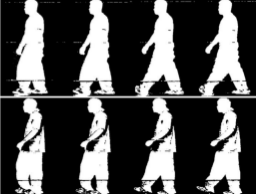 We have introduced a new video-based recognition method to recognize noncooperating individuals at a
distance in video who expose side views to the camera. Information from two biometrics sources, side face
and gait, is utilized and integrated for recognition. For side face, an enhanced side-face image (ESFI), a
higher resolution image compared with the image directly obtained from a single video frame, is constructed.
For gait, the gait energy image (GEI),
a spatiotemporal compact representation of gait in video, is used to characterize human-walking properties.
The experimental results show that the idea of constructing
ESFI from multiple frames is promising for human recognition in video, and better face features are extracted
from ESFI compared to those from the original side-face images (OSFIs).
We have introduced a new video-based recognition method to recognize noncooperating individuals at a
distance in video who expose side views to the camera. Information from two biometrics sources, side face
and gait, is utilized and integrated for recognition. For side face, an enhanced side-face image (ESFI), a
higher resolution image compared with the image directly obtained from a single video frame, is constructed.
For gait, the gait energy image (GEI),
a spatiotemporal compact representation of gait in video, is used to characterize human-walking properties.
The experimental results show that the idea of constructing
ESFI from multiple frames is promising for human recognition in video, and better face features are extracted
from ESFI compared to those from the original side-face images (OSFIs).
Individual Recognition Using Gait Energy Image
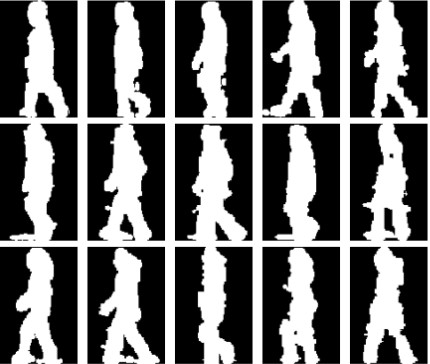 We propose a new spatio-temporal gait representation,
called Gait Energy Image (GEI), to characterize
human walking properties for individual recognition by
gait. To address the problem of the lack of training templates,
we generate a series of new GEI templates by analyzing
the human silhouette distortion under various conditions.
Principal component analysis followed by multiple
discriminant analysis are used for learning features from
the expanded GEI training templates. Recognition is carried
out based on the learned features. Experimental results
show that the proposed GEI is an effective and efficient gait
representation for individual recognition, and the proposed
approach achieves highly competitive performance with respect
to current gait recognition approaches.
We propose a new spatio-temporal gait representation,
called Gait Energy Image (GEI), to characterize
human walking properties for individual recognition by
gait. To address the problem of the lack of training templates,
we generate a series of new GEI templates by analyzing
the human silhouette distortion under various conditions.
Principal component analysis followed by multiple
discriminant analysis are used for learning features from
the expanded GEI training templates. Recognition is carried
out based on the learned features. Experimental results
show that the proposed GEI is an effective and efficient gait
representation for individual recognition, and the proposed
approach achieves highly competitive performance with respect
to current gait recognition approaches.
Fusion of Color and Infrared Video for Moving Human Detection
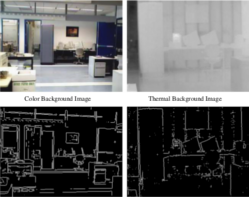 Image registration between color and thermal images is a challenging
problem due to the difficulties associated with finding correspondence. However, the moving people in a
static scene provide cues to address this problem. We propose a hierarchical scheme to
automatically find the correspondence between the preliminary human silhouettes extracted from synchronous
color and thermal image sequences for image registration. It is shown
that the proposed approach achieves good results for image registration and human silhouette extraction.
Experimental results also show a comparison of various sensor fusion strategies and demonstrate the
improvement in performance over non-fused cases for human silhouette extraction.
Image registration between color and thermal images is a challenging
problem due to the difficulties associated with finding correspondence. However, the moving people in a
static scene provide cues to address this problem. We propose a hierarchical scheme to
automatically find the correspondence between the preliminary human silhouettes extracted from synchronous
color and thermal image sequences for image registration. It is shown
that the proposed approach achieves good results for image registration and human silhouette extraction.
Experimental results also show a comparison of various sensor fusion strategies and demonstrate the
improvement in performance over non-fused cases for human silhouette extraction.
Feature Fusion of Face and Gait for Human Recognition at a Distance in Video
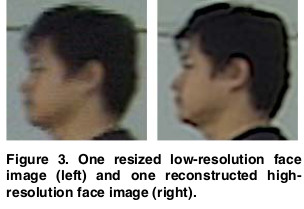 A new video based recognition method is presented
to recognize non-cooperating individuals at a distance in
video, who expose side views to the camera. Information
from two biometric sources, side face and gait, is utilized
and integrated at feature level. For face, a high-resolution
side face image is constructed from multiple video frames.
For gait, Gait Energy Image (GEI), a spatio-temporal compact
representation of gait in video, is used to characterize
human walking properties. Face features and gait features
are obtained separately using Principal Component Analysis
(PCA) and Multiple Discriminant Analysis (MDA) combined
method from the high-resolution side face image and
Gait Energy Image (GEI), respectively. The system is tested
on a database of video sequences corresponding to 46 people.
The results showed that the integrated face and gait
features carry the most discriminating power compared to
any individual biometric.
A new video based recognition method is presented
to recognize non-cooperating individuals at a distance in
video, who expose side views to the camera. Information
from two biometric sources, side face and gait, is utilized
and integrated at feature level. For face, a high-resolution
side face image is constructed from multiple video frames.
For gait, Gait Energy Image (GEI), a spatio-temporal compact
representation of gait in video, is used to characterize
human walking properties. Face features and gait features
are obtained separately using Principal Component Analysis
(PCA) and Multiple Discriminant Analysis (MDA) combined
method from the high-resolution side face image and
Gait Energy Image (GEI), respectively. The system is tested
on a database of video sequences corresponding to 46 people.
The results showed that the integrated face and gait
features carry the most discriminating power compared to
any individual biometric.
Human Activity Classification Based on Gait Energy Image and Coevolutionary Genetic Programming
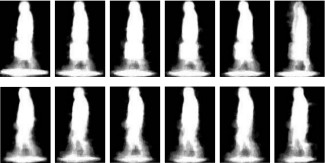 We present a novel approach based on
gait energy image (GEI) and co-evolutionary genetic
programming (CGP) for human activity classification.
Specifically, Hu’s moment and normalized histogram
bins are extracted from the original GEIs as input
features. CGP is employed to reduce the feature
dimensionality and learn the classifiers. The strategy
of majority voting is applied to the CGP to improve the
overall performance in consideration of the
diversification of genetic programming. This learning based
approach improves the classification accuracy
by approximately 7 percent in comparison to the
traditional classifiers.
We present a novel approach based on
gait energy image (GEI) and co-evolutionary genetic
programming (CGP) for human activity classification.
Specifically, Hu’s moment and normalized histogram
bins are extracted from the original GEIs as input
features. CGP is employed to reduce the feature
dimensionality and learn the classifiers. The strategy
of majority voting is applied to the CGP to improve the
overall performance in consideration of the
diversification of genetic programming. This learning based
approach improves the classification accuracy
by approximately 7 percent in comparison to the
traditional classifiers.
Integrating Face and Gait for Human Recognition
 We introduce a new video based recognition
method to recognize non-cooperating individuals at a distance
in video, who expose side views to the camera. Information
from two biometric sources, side face and gait,
is utilized and integrated for recognition. For side face, we
construct Enhanced Side Face Image (ESFI), a higher resolution
image compared with the image directly obtained
from a single video frame, to fuse information of face from
multiple video frames. For gait, we use Gait Energy Image
(GEI), a spatio-temporal compact representation of gait in
video, to characterize human walking properties. The features
of face and the features of gait are obtained separately
using Principal Component Analysis (PCA) and Multiple
Discriminant Analysis (MDA) combined method from ESFI
and GEI, respectively. They are then integrated at match
score level. Our approach is tested on a database of video
sequences corresponding to 46 people. The different fusion
methods are compared and analyzed. The experimental results
show that (a) Integrated information from side face
and gait is effective for human recognition in video; (b) The
idea of constructing ESFI from multiple frames is promising
for human recognition in video and better face features are
extracted from ESFI compared to those from original face
images.
We introduce a new video based recognition
method to recognize non-cooperating individuals at a distance
in video, who expose side views to the camera. Information
from two biometric sources, side face and gait,
is utilized and integrated for recognition. For side face, we
construct Enhanced Side Face Image (ESFI), a higher resolution
image compared with the image directly obtained
from a single video frame, to fuse information of face from
multiple video frames. For gait, we use Gait Energy Image
(GEI), a spatio-temporal compact representation of gait in
video, to characterize human walking properties. The features
of face and the features of gait are obtained separately
using Principal Component Analysis (PCA) and Multiple
Discriminant Analysis (MDA) combined method from ESFI
and GEI, respectively. They are then integrated at match
score level. Our approach is tested on a database of video
sequences corresponding to 46 people. The different fusion
methods are compared and analyzed. The experimental results
show that (a) Integrated information from side face
and gait is effective for human recognition in video; (b) The
idea of constructing ESFI from multiple frames is promising
for human recognition in video and better face features are
extracted from ESFI compared to those from original face
images.
A Study on View-insensitive Gait Recognition
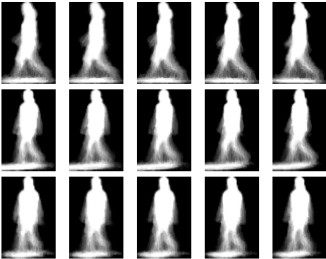 Most gait recognition approaches only study human walking
fronto parallel to the image plane which is not realistic
in video surveillance applications. Human gait appearance
depends on various factors including locations of the camera
and the person, the camera axis and the walking direction.
By analyzing these factors, we propose a statistical
approach for view-insensitive gait recognition. The proposed
approach recognizes human using a single camera,
and avoids the difficulties of recovering the human body
structure and camera calibration. Experimental results show
that the proposed approach achieves good performance in
recognizing individuals walking along different directions.
Most gait recognition approaches only study human walking
fronto parallel to the image plane which is not realistic
in video surveillance applications. Human gait appearance
depends on various factors including locations of the camera
and the person, the camera axis and the walking direction.
By analyzing these factors, we propose a statistical
approach for view-insensitive gait recognition. The proposed
approach recognizes human using a single camera,
and avoids the difficulties of recovering the human body
structure and camera calibration. Experimental results show
that the proposed approach achieves good performance in
recognizing individuals walking along different directions.
Human recognition at a distance in video by integrating face profile and gait
.png) Human recognition from arbitrary views is an important task for many applications, such as visual surveillance, covert security and access control. It has been found to be very difficult in reality, especially when a person is walking at a distance in read-world outdoor conditions. For optimal performance, the system should use as much information as possible from the observations. In this paper, we propose an innovative system, which combines cues of face profile and gait silhouette from the single camera video sequences. For optimal face profile recognition, we first reconstruct a high-resolution face profile image from several adjacent low-resolution video frames. Then we use a curvature-based matching method for recognition. For gait, we use Gait Energy Image (GEI) to characterize human walking properties. Recognition is carried out based on the direct GEI matching. Several schemes are considered for fusion of face profile and gait. A number of dynamic video sequences are tested to evaluate the performance of our system. Experiment results are compared and discussed.
Human recognition from arbitrary views is an important task for many applications, such as visual surveillance, covert security and access control. It has been found to be very difficult in reality, especially when a person is walking at a distance in read-world outdoor conditions. For optimal performance, the system should use as much information as possible from the observations. In this paper, we propose an innovative system, which combines cues of face profile and gait silhouette from the single camera video sequences. For optimal face profile recognition, we first reconstruct a high-resolution face profile image from several adjacent low-resolution video frames. Then we use a curvature-based matching method for recognition. For gait, we use Gait Energy Image (GEI) to characterize human walking properties. Recognition is carried out based on the direct GEI matching. Several schemes are considered for fusion of face profile and gait. A number of dynamic video sequences are tested to evaluate the performance of our system. Experiment results are compared and discussed.
Gait recognition by combining classifiers based on environmental contexts
.png) Human gait properties can be affected by various environmental contexts such as walking surface and carrying objects. In this paper, we propose a novel approach for individual recognition by combining different gait classifiers with the knowledge of environmental contexts to improve the recognition performance. Different classifiers are designed to handle different environmental contexts, and context specific features are explored for context characterization. In the recognition procedure, we can determine the probability of environmental contexts in any probe sequence according to its context features, and apply the probabilistic classifier combination strategies for the recognition. Experimental results demonstrate the effectiveness of the proposed approach.
Human gait properties can be affected by various environmental contexts such as walking surface and carrying objects. In this paper, we propose a novel approach for individual recognition by combining different gait classifiers with the knowledge of environmental contexts to improve the recognition performance. Different classifiers are designed to handle different environmental contexts, and context specific features are explored for context characterization. In the recognition procedure, we can determine the probability of environmental contexts in any probe sequence according to its context features, and apply the probabilistic classifier combination strategies for the recognition. Experimental results demonstrate the effectiveness of the proposed approach.
Human Activity Recognition in Thermal Infrared Imagery
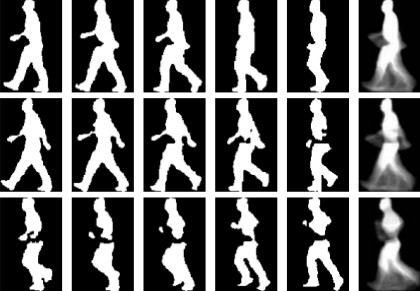 Here we investigate human repetitive activity
properties from thermal infrared imagery, where human
motion can be easily detected from the background regardless
of lighting conditions and colors of the human surfaces
and backgrounds. We employ an efficient spatio-temporal
representation for human repetitive activity recognition,
which represents human motion sequence in a single
image while preserving some temporal information. A
statistical approach is used to extract features for activity
recognition. Experimental results show that the proposed
approach achieves good performance for human repetitive
activity recognition.
Here we investigate human repetitive activity
properties from thermal infrared imagery, where human
motion can be easily detected from the background regardless
of lighting conditions and colors of the human surfaces
and backgrounds. We employ an efficient spatio-temporal
representation for human repetitive activity recognition,
which represents human motion sequence in a single
image while preserving some temporal information. A
statistical approach is used to extract features for activity
recognition. Experimental results show that the proposed
approach achieves good performance for human repetitive
activity recognition.
Performance Prediction for Individual Recognition by Gait
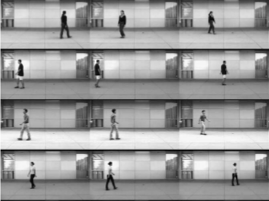 Existing gait recognition approaches do not give their theoretical or experimental performance predictions.
Therefore, the discriminating power of gait as a feature for human recognition cannot be evaluated. We propose a kinematic-based approach to recognize human by gait. The proposed approach
estimates 3D human walking parameters by performing a least squares fit of the 3D kinematic model to the
2D silhouette extracted from a monocular image sequence.
Existing gait recognition approaches do not give their theoretical or experimental performance predictions.
Therefore, the discriminating power of gait as a feature for human recognition cannot be evaluated. We propose a kinematic-based approach to recognize human by gait. The proposed approach
estimates 3D human walking parameters by performing a least squares fit of the 3D kinematic model to the
2D silhouette extracted from a monocular image sequence.
Individual Recognition Using Gait Energy Image
.png) In this paper, we propose a new spatio-temporal gait representation, called Gait Energy Image (GEI), to characterize human walking properties for individual recognition by gait. To address the problem of the lack of training templates, we generate a series of new GEI templates by analyzing the human silhouette distortion under various conditions. Principal component analysis followed by multiple discriminant analysis are used for learning features from the expanded GEI training templates. Recognition is carried out based on the learned features. Experimental results show that the proposed GEI is an effective and efficient gait representation for individual recognition, and the proposed approach achieves highly competitive performance with respect to current gait recognition approaches.
In this paper, we propose a new spatio-temporal gait representation, called Gait Energy Image (GEI), to characterize human walking properties for individual recognition by gait. To address the problem of the lack of training templates, we generate a series of new GEI templates by analyzing the human silhouette distortion under various conditions. Principal component analysis followed by multiple discriminant analysis are used for learning features from the expanded GEI training templates. Recognition is carried out based on the learned features. Experimental results show that the proposed GEI is an effective and efficient gait representation for individual recognition, and the proposed approach achieves highly competitive performance with respect to current gait recognition approaches.
Statistical Feature Fusion for Gait-based Human Recognition
 This paper presents a novel approach for human recognition
by combining statistical gait features from real and
synthetic templates. Real templates are directly computed
from training silhouette sequences, while synthetic templates
are generated from training sequences by simulating
silhouette distortion. A statistical feature extraction approach
is used for learning effective features from real and
synthetic templates. Features learned from real templates
characterize human walking properties provided in training
sequences, and features learned from synthetic templates
predict gait properties under other conditions. A feature fusion
strategy is therefore applied at the decision level to improve
recognition performance. We apply the proposed approach
to USF HumanID Database. Experimental results
demonstrate that the proposed fusion approach not only
achieves better performance than individual approaches,
but also provides large improvement in performance with
respect to the baseline algorithm.
This paper presents a novel approach for human recognition
by combining statistical gait features from real and
synthetic templates. Real templates are directly computed
from training silhouette sequences, while synthetic templates
are generated from training sequences by simulating
silhouette distortion. A statistical feature extraction approach
is used for learning effective features from real and
synthetic templates. Features learned from real templates
characterize human walking properties provided in training
sequences, and features learned from synthetic templates
predict gait properties under other conditions. A feature fusion
strategy is therefore applied at the decision level to improve
recognition performance. We apply the proposed approach
to USF HumanID Database. Experimental results
demonstrate that the proposed fusion approach not only
achieves better performance than individual approaches,
but also provides large improvement in performance with
respect to the baseline algorithm.
Gait Energy Image Representation: Comparative Performance Evaluation on USF HumanID Database
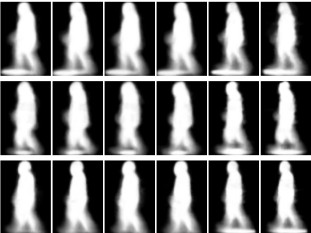 A new spatio-temporal gait representation, called Gait Energy Image (GEI), is proposed to
characterize human walking properties for individual recognition by gait. To address the problem of the lack
of training templates, we expand the training templates by analyzing the human silhouette distortion under various conditions.
Principal component analysis and multiple discriminant analysis are used for learning features from the expanded
GEI based gait recognition approaches with other gait recognition approaches on USF HumanID Database. Experimental
results show that the proposed GEI is an effective and efficient gait representation for individual recognition,
and the proposed approach achieves highly competitive performance with respect to current gait recognition
approaches.
A new spatio-temporal gait representation, called Gait Energy Image (GEI), is proposed to
characterize human walking properties for individual recognition by gait. To address the problem of the lack
of training templates, we expand the training templates by analyzing the human silhouette distortion under various conditions.
Principal component analysis and multiple discriminant analysis are used for learning features from the expanded
GEI based gait recognition approaches with other gait recognition approaches on USF HumanID Database. Experimental
results show that the proposed GEI is an effective and efficient gait representation for individual recognition,
and the proposed approach achieves highly competitive performance with respect to current gait recognition
approaches.
Human Recognition on Combining Kinematic and Stationary Features
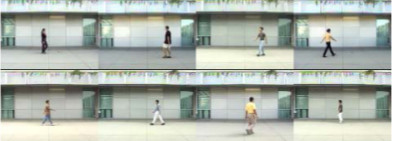 Both the human motion characteristics and body part measurement are important cues for human recognition
at a distance. The former can be viewed as kinematic measurement while the latter is stationary measurement.
We propose a kinematic based approach to extract both kinematic and stationary features for human
recognition. The proposed approach first estimates 3D human walking parameters by fitting the 3D kinematic model to
the 2D silhouette extracted from a monocular image sequence. Kinematic and stationary features are then extracted
from the kinematic and stationary parameters, respectively, and used for human recognition separately. Next, we
discuss different strategies for combining kinematic and stationary features to make a decision. Experimental
results show a comparison of these combination strategies and demonstrate the improvement in performance
for human recognition.
Both the human motion characteristics and body part measurement are important cues for human recognition
at a distance. The former can be viewed as kinematic measurement while the latter is stationary measurement.
We propose a kinematic based approach to extract both kinematic and stationary features for human
recognition. The proposed approach first estimates 3D human walking parameters by fitting the 3D kinematic model to
the 2D silhouette extracted from a monocular image sequence. Kinematic and stationary features are then extracted
from the kinematic and stationary parameters, respectively, and used for human recognition separately. Next, we
discuss different strategies for combining kinematic and stationary features to make a decision. Experimental
results show a comparison of these combination strategies and demonstrate the improvement in performance
for human recognition.
Bayesian-based performance prediction for gait recognition
.png) Existing gait recognition approaches do not give their theoretical or experiential performance predictions. Therefore, the discriminating power of gait as a feature for human recognition cannot be evaluated. We first propose a kinematic-based approach to recognize humans by gait. The proposed. approach estimates 3D human walking parameters by performing a least squares fit of the 3D kinematic model to the 2D silhouette extracted from a monocular image sequence. Next, a Bayesian based statistical analysis is performed to evaluate the discriminating power of the extracted features. Through probabilistic simulation, we not only predict the probability of correct recognition (PCR) with regard to different within-class feature variance, but also obtain the upper bound on PCR with regard to different human silhouette resolutions. In addition, the maximum number of people in a database is obtained given the allowable error rate. This is extremely important for gait recognition in large databases.
Existing gait recognition approaches do not give their theoretical or experiential performance predictions. Therefore, the discriminating power of gait as a feature for human recognition cannot be evaluated. We first propose a kinematic-based approach to recognize humans by gait. The proposed. approach estimates 3D human walking parameters by performing a least squares fit of the 3D kinematic model to the 2D silhouette extracted from a monocular image sequence. Next, a Bayesian based statistical analysis is performed to evaluate the discriminating power of the extracted features. Through probabilistic simulation, we not only predict the probability of correct recognition (PCR) with regard to different within-class feature variance, but also obtain the upper bound on PCR with regard to different human silhouette resolutions. In addition, the maximum number of people in a database is obtained given the allowable error rate. This is extremely important for gait recognition in large databases.
Kinematic-based human motion analysis in infrared sequences
.png) In an infrared (IR) image sequence of human walking, the human silhouette can be reliably extracted from the background regardless of lighting conditions and colors of the human surfaces and backgrounds in most cases. Moreover, some important regions containing skin, such as face and hands, can be accurately detected in IR image sequences. In this paper, we propose a kinematic-based approach for automatic human motion analysis from IR image sequences. The proposed approach estimates 3D human walking parameters by performing a modified least squares fit of the 3D kinematic model to the 2D silhouette extracted from a monocular IR image sequence, where continuity and symmetry of human walking and detected hand regions are also considered in the optimization function. Experimental results show that the proposed approach achieves good performance in gait analysis with different view angles With respect to the walking direction, and is promising for further gait recognition.
In an infrared (IR) image sequence of human walking, the human silhouette can be reliably extracted from the background regardless of lighting conditions and colors of the human surfaces and backgrounds in most cases. Moreover, some important regions containing skin, such as face and hands, can be accurately detected in IR image sequences. In this paper, we propose a kinematic-based approach for automatic human motion analysis from IR image sequences. The proposed approach estimates 3D human walking parameters by performing a modified least squares fit of the 3D kinematic model to the 2D silhouette extracted from a monocular IR image sequence, where continuity and symmetry of human walking and detected hand regions are also considered in the optimization function. Experimental results show that the proposed approach achieves good performance in gait analysis with different view angles With respect to the walking direction, and is promising for further gait recognition.
Individual recognition by kinematic-based gait analysis
.png) Current gait recognition approaches only consider individuals walking frontopamllel to the image plane. This makes them inapplicoble for recognizing individuals walking from different angles with respect to the image plane. In this paper, we propose a kinematic-based approach to recognize individuals by gait. The proposed approach estimates 30 human walking parameters by performing a least squares fit of the 30 kinematic model to the 20 silhouette eztmctedfmm a monocular image sequence. A genetic algorithm is used for feature selection from the estimated parameters, and the individuals are then recognized from the feature vectors using a nearest neighbor method. Ezperimental results show that the proposed approach achieves good performance in recognizing individuals walking fmm different angles with respect to the image plane.
Current gait recognition approaches only consider individuals walking frontopamllel to the image plane. This makes them inapplicoble for recognizing individuals walking from different angles with respect to the image plane. In this paper, we propose a kinematic-based approach to recognize individuals by gait. The proposed approach estimates 30 human walking parameters by performing a least squares fit of the 30 kinematic model to the 20 silhouette eztmctedfmm a monocular image sequence. A genetic algorithm is used for feature selection from the estimated parameters, and the individuals are then recognized from the feature vectors using a nearest neighbor method. Ezperimental results show that the proposed approach achieves good performance in recognizing individuals walking fmm different angles with respect to the image plane.
|
|


 We have proposed a new framework for age
classification based on human gait using the Hidden
Markov Model (HMM). To extract
appropriate gait features, we consider a contour
related method in terms of shape variations during
human walking. Then the image feature is transformed
to a lower-dimensional space by using the Frame to
Exemplar (FED) distance. A HMM is trained on the
FED vector sequences. Thus, the framework provides
flexibility in the selection of gait feature representation.
In addition, the framework is robust for classification
due to the statistical nature of HMM. The experimental
results show that video-based automatic age
classification from human gait is feasible and reliable.
We have proposed a new framework for age
classification based on human gait using the Hidden
Markov Model (HMM). To extract
appropriate gait features, we consider a contour
related method in terms of shape variations during
human walking. Then the image feature is transformed
to a lower-dimensional space by using the Frame to
Exemplar (FED) distance. A HMM is trained on the
FED vector sequences. Thus, the framework provides
flexibility in the selection of gait feature representation.
In addition, the framework is robust for classification
due to the statistical nature of HMM. The experimental
results show that video-based automatic age
classification from human gait is feasible and reliable.
 The determination of ethnicity of an individual, as a soft
biometrics, can be very useful in a video-based surveillance
system. Currently, face is commonly used to determine the
ethnicity of a person. Up to now, gait has been used for
individual recognition and gender classification but not for
ethnicity determination. Gait Energy
Image (GEI) is used in this research to analyze the recognition power
of gait for ethnicity. Feature fusion, score fusion and decision
fusion from multiple views of gait are explored. For
the feature fusion, GEI images and camera views are put
together to render a third-order tensor (x; y; view). A multilinear
principal component analysis (MPCA) is used to extract
features from tensor objects which integrate all views.
For the score fusion, the similarity scores measured from
single views are combined with a weighted SUM rule. For
the decision fusion, ethnicity classification is realized on
each individual view first. The classification results are then
combined to make the final determination with a majority
vote rule. A database of 36 walking people (East Asian
and South American) was acquired from 7 different camera
views. The experimental results show that ethnicity can
be determined from human gait in video automatically. The
classification rate is improved by fusing multiple camera
views and a comparison among different fusion schemes
shows that the MPCA based feature fusion performs the
best.
The determination of ethnicity of an individual, as a soft
biometrics, can be very useful in a video-based surveillance
system. Currently, face is commonly used to determine the
ethnicity of a person. Up to now, gait has been used for
individual recognition and gender classification but not for
ethnicity determination. Gait Energy
Image (GEI) is used in this research to analyze the recognition power
of gait for ethnicity. Feature fusion, score fusion and decision
fusion from multiple views of gait are explored. For
the feature fusion, GEI images and camera views are put
together to render a third-order tensor (x; y; view). A multilinear
principal component analysis (MPCA) is used to extract
features from tensor objects which integrate all views.
For the score fusion, the similarity scores measured from
single views are combined with a weighted SUM rule. For
the decision fusion, ethnicity classification is realized on
each individual view first. The classification results are then
combined to make the final determination with a majority
vote rule. A database of 36 walking people (East Asian
and South American) was acquired from 7 different camera
views. The experimental results show that ethnicity can
be determined from human gait in video automatically. The
classification rate is improved by fusing multiple camera
views and a comparison among different fusion schemes
shows that the MPCA based feature fusion performs the
best.
.png) Video networks is an emerging interdisciplinary field with significant and exciting scientific and technological challenges. It has great promise in solving many real-world problems and enabling a broad range of applications, including smart homes, video surveillance, environment and traffic monitoring, elderly care, intelligent environments, and entertainment in public and private spaces. This paper provides an overview of the design of a wireless video network as an experimental environment, camera selection, hand-off and control, anomaly detection. It addresses challenging questions for individual identification using gait and face at a distance and present new techniques and their comparison for robust identification.
Video networks is an emerging interdisciplinary field with significant and exciting scientific and technological challenges. It has great promise in solving many real-world problems and enabling a broad range of applications, including smart homes, video surveillance, environment and traffic monitoring, elderly care, intelligent environments, and entertainment in public and private spaces. This paper provides an overview of the design of a wireless video network as an experimental environment, camera selection, hand-off and control, anomaly detection. It addresses challenging questions for individual identification using gait and face at a distance and present new techniques and their comparison for robust identification.
 It has been challenging to recognize walking humans
at arbitrary poses from a single or small number of video
cameras. Attempts have been made mostly using a 2D
image/silhouette-based representation and a limited use of
3D kinematic model-based approaches. Unlike all the previous work in computer vision
and pattern recognition, the models of walking humans
are built using the sensed 3D range data at selected poses
without any markers. An instance of a walking individual
at a different pose is recognized using the 3D range data of
that pose. Both modeling and recognition of an individual
are done using the dense 3D range data. The proposed approach
first measures 3D human body data that consists of
the representative poses during a gait cycle. Next, a 3D human
body model is fitted to the body data using an approach
that overcomes the inherent gaps in the data and estimates
the body pose with high accuracy. A gait sequence is synthesized
by interpolation of joint positions and their movements
from the fitted body models. Both dynamic and static
gait features are obtained which are used to define a similarity
measure for an individual recognition in the database.
The experimental results show high recognition rates using
our range based 3D gait database.
It has been challenging to recognize walking humans
at arbitrary poses from a single or small number of video
cameras. Attempts have been made mostly using a 2D
image/silhouette-based representation and a limited use of
3D kinematic model-based approaches. Unlike all the previous work in computer vision
and pattern recognition, the models of walking humans
are built using the sensed 3D range data at selected poses
without any markers. An instance of a walking individual
at a different pose is recognized using the 3D range data of
that pose. Both modeling and recognition of an individual
are done using the dense 3D range data. The proposed approach
first measures 3D human body data that consists of
the representative poses during a gait cycle. Next, a 3D human
body model is fitted to the body data using an approach
that overcomes the inherent gaps in the data and estimates
the body pose with high accuracy. A gait sequence is synthesized
by interpolation of joint positions and their movements
from the fitted body models. Both dynamic and static
gait features are obtained which are used to define a similarity
measure for an individual recognition in the database.
The experimental results show high recognition rates using
our range based 3D gait database.
.png) This paper consider face, side face, gait and ear and their possible fusion for human recognition. It presents an overview of some of the techniques that we have developed for (a) super-resoulution-based face recognition in video, (b) gait-based recognition in video, (c) fusion of super-resolved side face and gait in video, (d) ear recognition in color/range images, and (e) fusion performance prediction and validation. It presents various real-world examples to illustrate the ideas and points out the relative merits of the approaches that are discussed.
This paper consider face, side face, gait and ear and their possible fusion for human recognition. It presents an overview of some of the techniques that we have developed for (a) super-resoulution-based face recognition in video, (b) gait-based recognition in video, (c) fusion of super-resolved side face and gait in video, (d) ear recognition in color/range images, and (e) fusion performance prediction and validation. It presents various real-world examples to illustrate the ideas and points out the relative merits of the approaches that are discussed.
 Video-based human recognition at a distance remains a challenging problem for the fusion of multimodal
biometrics. We present a
new approach that utilizes and integrates information from side face and gait at the feature level. The features of
face and gait are obtained separately using principal component analysis (PCA) from enhanced side face image
(ESFI) and gait energy image (GEI), respectively. Multiple discriminant analysis (MDA) is employed on the
concatenated features of face and gait to obtain discriminating synthetic features. The experimental results demonstrate that the synthetic features, encoding both side face and gait
information, carry more discriminating power than the individual biometrics features, and the proposed feature
level fusion scheme outperforms the match score level and another feature level fusion scheme.
Video-based human recognition at a distance remains a challenging problem for the fusion of multimodal
biometrics. We present a
new approach that utilizes and integrates information from side face and gait at the feature level. The features of
face and gait are obtained separately using principal component analysis (PCA) from enhanced side face image
(ESFI) and gait energy image (GEI), respectively. Multiple discriminant analysis (MDA) is employed on the
concatenated features of face and gait to obtain discriminating synthetic features. The experimental results demonstrate that the synthetic features, encoding both side face and gait
information, carry more discriminating power than the individual biometrics features, and the proposed feature
level fusion scheme outperforms the match score level and another feature level fusion scheme.
 We have introduced a new video-based recognition method to recognize noncooperating individuals at a
distance in video who expose side views to the camera. Information from two biometrics sources, side face
and gait, is utilized and integrated for recognition. For side face, an enhanced side-face image (ESFI), a
higher resolution image compared with the image directly obtained from a single video frame, is constructed.
For gait, the gait energy image (GEI),
a spatiotemporal compact representation of gait in video, is used to characterize human-walking properties.
The experimental results show that the idea of constructing
ESFI from multiple frames is promising for human recognition in video, and better face features are extracted
from ESFI compared to those from the original side-face images (OSFIs).
We have introduced a new video-based recognition method to recognize noncooperating individuals at a
distance in video who expose side views to the camera. Information from two biometrics sources, side face
and gait, is utilized and integrated for recognition. For side face, an enhanced side-face image (ESFI), a
higher resolution image compared with the image directly obtained from a single video frame, is constructed.
For gait, the gait energy image (GEI),
a spatiotemporal compact representation of gait in video, is used to characterize human-walking properties.
The experimental results show that the idea of constructing
ESFI from multiple frames is promising for human recognition in video, and better face features are extracted
from ESFI compared to those from the original side-face images (OSFIs).
 We propose a new spatio-temporal gait representation,
called Gait Energy Image (GEI), to characterize
human walking properties for individual recognition by
gait. To address the problem of the lack of training templates,
we generate a series of new GEI templates by analyzing
the human silhouette distortion under various conditions.
Principal component analysis followed by multiple
discriminant analysis are used for learning features from
the expanded GEI training templates. Recognition is carried
out based on the learned features. Experimental results
show that the proposed GEI is an effective and efficient gait
representation for individual recognition, and the proposed
approach achieves highly competitive performance with respect
to current gait recognition approaches.
We propose a new spatio-temporal gait representation,
called Gait Energy Image (GEI), to characterize
human walking properties for individual recognition by
gait. To address the problem of the lack of training templates,
we generate a series of new GEI templates by analyzing
the human silhouette distortion under various conditions.
Principal component analysis followed by multiple
discriminant analysis are used for learning features from
the expanded GEI training templates. Recognition is carried
out based on the learned features. Experimental results
show that the proposed GEI is an effective and efficient gait
representation for individual recognition, and the proposed
approach achieves highly competitive performance with respect
to current gait recognition approaches.
 Image registration between color and thermal images is a challenging
problem due to the difficulties associated with finding correspondence. However, the moving people in a
static scene provide cues to address this problem. We propose a hierarchical scheme to
automatically find the correspondence between the preliminary human silhouettes extracted from synchronous
color and thermal image sequences for image registration. It is shown
that the proposed approach achieves good results for image registration and human silhouette extraction.
Experimental results also show a comparison of various sensor fusion strategies and demonstrate the
improvement in performance over non-fused cases for human silhouette extraction.
Image registration between color and thermal images is a challenging
problem due to the difficulties associated with finding correspondence. However, the moving people in a
static scene provide cues to address this problem. We propose a hierarchical scheme to
automatically find the correspondence between the preliminary human silhouettes extracted from synchronous
color and thermal image sequences for image registration. It is shown
that the proposed approach achieves good results for image registration and human silhouette extraction.
Experimental results also show a comparison of various sensor fusion strategies and demonstrate the
improvement in performance over non-fused cases for human silhouette extraction.
 A new video based recognition method is presented
to recognize non-cooperating individuals at a distance in
video, who expose side views to the camera. Information
from two biometric sources, side face and gait, is utilized
and integrated at feature level. For face, a high-resolution
side face image is constructed from multiple video frames.
For gait, Gait Energy Image (GEI), a spatio-temporal compact
representation of gait in video, is used to characterize
human walking properties. Face features and gait features
are obtained separately using Principal Component Analysis
(PCA) and Multiple Discriminant Analysis (MDA) combined
method from the high-resolution side face image and
Gait Energy Image (GEI), respectively. The system is tested
on a database of video sequences corresponding to 46 people.
The results showed that the integrated face and gait
features carry the most discriminating power compared to
any individual biometric.
A new video based recognition method is presented
to recognize non-cooperating individuals at a distance in
video, who expose side views to the camera. Information
from two biometric sources, side face and gait, is utilized
and integrated at feature level. For face, a high-resolution
side face image is constructed from multiple video frames.
For gait, Gait Energy Image (GEI), a spatio-temporal compact
representation of gait in video, is used to characterize
human walking properties. Face features and gait features
are obtained separately using Principal Component Analysis
(PCA) and Multiple Discriminant Analysis (MDA) combined
method from the high-resolution side face image and
Gait Energy Image (GEI), respectively. The system is tested
on a database of video sequences corresponding to 46 people.
The results showed that the integrated face and gait
features carry the most discriminating power compared to
any individual biometric.
 We present a novel approach based on
gait energy image (GEI) and co-evolutionary genetic
programming (CGP) for human activity classification.
Specifically, Hu’s moment and normalized histogram
bins are extracted from the original GEIs as input
features. CGP is employed to reduce the feature
dimensionality and learn the classifiers. The strategy
of majority voting is applied to the CGP to improve the
overall performance in consideration of the
diversification of genetic programming. This learning based
approach improves the classification accuracy
by approximately 7 percent in comparison to the
traditional classifiers.
We present a novel approach based on
gait energy image (GEI) and co-evolutionary genetic
programming (CGP) for human activity classification.
Specifically, Hu’s moment and normalized histogram
bins are extracted from the original GEIs as input
features. CGP is employed to reduce the feature
dimensionality and learn the classifiers. The strategy
of majority voting is applied to the CGP to improve the
overall performance in consideration of the
diversification of genetic programming. This learning based
approach improves the classification accuracy
by approximately 7 percent in comparison to the
traditional classifiers.
 We introduce a new video based recognition
method to recognize non-cooperating individuals at a distance
in video, who expose side views to the camera. Information
from two biometric sources, side face and gait,
is utilized and integrated for recognition. For side face, we
construct Enhanced Side Face Image (ESFI), a higher resolution
image compared with the image directly obtained
from a single video frame, to fuse information of face from
multiple video frames. For gait, we use Gait Energy Image
(GEI), a spatio-temporal compact representation of gait in
video, to characterize human walking properties. The features
of face and the features of gait are obtained separately
using Principal Component Analysis (PCA) and Multiple
Discriminant Analysis (MDA) combined method from ESFI
and GEI, respectively. They are then integrated at match
score level. Our approach is tested on a database of video
sequences corresponding to 46 people. The different fusion
methods are compared and analyzed. The experimental results
show that (a) Integrated information from side face
and gait is effective for human recognition in video; (b) The
idea of constructing ESFI from multiple frames is promising
for human recognition in video and better face features are
extracted from ESFI compared to those from original face
images.
We introduce a new video based recognition
method to recognize non-cooperating individuals at a distance
in video, who expose side views to the camera. Information
from two biometric sources, side face and gait,
is utilized and integrated for recognition. For side face, we
construct Enhanced Side Face Image (ESFI), a higher resolution
image compared with the image directly obtained
from a single video frame, to fuse information of face from
multiple video frames. For gait, we use Gait Energy Image
(GEI), a spatio-temporal compact representation of gait in
video, to characterize human walking properties. The features
of face and the features of gait are obtained separately
using Principal Component Analysis (PCA) and Multiple
Discriminant Analysis (MDA) combined method from ESFI
and GEI, respectively. They are then integrated at match
score level. Our approach is tested on a database of video
sequences corresponding to 46 people. The different fusion
methods are compared and analyzed. The experimental results
show that (a) Integrated information from side face
and gait is effective for human recognition in video; (b) The
idea of constructing ESFI from multiple frames is promising
for human recognition in video and better face features are
extracted from ESFI compared to those from original face
images.
 Most gait recognition approaches only study human walking
fronto parallel to the image plane which is not realistic
in video surveillance applications. Human gait appearance
depends on various factors including locations of the camera
and the person, the camera axis and the walking direction.
By analyzing these factors, we propose a statistical
approach for view-insensitive gait recognition. The proposed
approach recognizes human using a single camera,
and avoids the difficulties of recovering the human body
structure and camera calibration. Experimental results show
that the proposed approach achieves good performance in
recognizing individuals walking along different directions.
Most gait recognition approaches only study human walking
fronto parallel to the image plane which is not realistic
in video surveillance applications. Human gait appearance
depends on various factors including locations of the camera
and the person, the camera axis and the walking direction.
By analyzing these factors, we propose a statistical
approach for view-insensitive gait recognition. The proposed
approach recognizes human using a single camera,
and avoids the difficulties of recovering the human body
structure and camera calibration. Experimental results show
that the proposed approach achieves good performance in
recognizing individuals walking along different directions.
.png) Human recognition from arbitrary views is an important task for many applications, such as visual surveillance, covert security and access control. It has been found to be very difficult in reality, especially when a person is walking at a distance in read-world outdoor conditions. For optimal performance, the system should use as much information as possible from the observations. In this paper, we propose an innovative system, which combines cues of face profile and gait silhouette from the single camera video sequences. For optimal face profile recognition, we first reconstruct a high-resolution face profile image from several adjacent low-resolution video frames. Then we use a curvature-based matching method for recognition. For gait, we use Gait Energy Image (GEI) to characterize human walking properties. Recognition is carried out based on the direct GEI matching. Several schemes are considered for fusion of face profile and gait. A number of dynamic video sequences are tested to evaluate the performance of our system. Experiment results are compared and discussed.
Human recognition from arbitrary views is an important task for many applications, such as visual surveillance, covert security and access control. It has been found to be very difficult in reality, especially when a person is walking at a distance in read-world outdoor conditions. For optimal performance, the system should use as much information as possible from the observations. In this paper, we propose an innovative system, which combines cues of face profile and gait silhouette from the single camera video sequences. For optimal face profile recognition, we first reconstruct a high-resolution face profile image from several adjacent low-resolution video frames. Then we use a curvature-based matching method for recognition. For gait, we use Gait Energy Image (GEI) to characterize human walking properties. Recognition is carried out based on the direct GEI matching. Several schemes are considered for fusion of face profile and gait. A number of dynamic video sequences are tested to evaluate the performance of our system. Experiment results are compared and discussed.
.png) Human gait properties can be affected by various environmental contexts such as walking surface and carrying objects. In this paper, we propose a novel approach for individual recognition by combining different gait classifiers with the knowledge of environmental contexts to improve the recognition performance. Different classifiers are designed to handle different environmental contexts, and context specific features are explored for context characterization. In the recognition procedure, we can determine the probability of environmental contexts in any probe sequence according to its context features, and apply the probabilistic classifier combination strategies for the recognition. Experimental results demonstrate the effectiveness of the proposed approach.
Human gait properties can be affected by various environmental contexts such as walking surface and carrying objects. In this paper, we propose a novel approach for individual recognition by combining different gait classifiers with the knowledge of environmental contexts to improve the recognition performance. Different classifiers are designed to handle different environmental contexts, and context specific features are explored for context characterization. In the recognition procedure, we can determine the probability of environmental contexts in any probe sequence according to its context features, and apply the probabilistic classifier combination strategies for the recognition. Experimental results demonstrate the effectiveness of the proposed approach.
 Here we investigate human repetitive activity
properties from thermal infrared imagery, where human
motion can be easily detected from the background regardless
of lighting conditions and colors of the human surfaces
and backgrounds. We employ an efficient spatio-temporal
representation for human repetitive activity recognition,
which represents human motion sequence in a single
image while preserving some temporal information. A
statistical approach is used to extract features for activity
recognition. Experimental results show that the proposed
approach achieves good performance for human repetitive
activity recognition.
Here we investigate human repetitive activity
properties from thermal infrared imagery, where human
motion can be easily detected from the background regardless
of lighting conditions and colors of the human surfaces
and backgrounds. We employ an efficient spatio-temporal
representation for human repetitive activity recognition,
which represents human motion sequence in a single
image while preserving some temporal information. A
statistical approach is used to extract features for activity
recognition. Experimental results show that the proposed
approach achieves good performance for human repetitive
activity recognition.
 Existing gait recognition approaches do not give their theoretical or experimental performance predictions.
Therefore, the discriminating power of gait as a feature for human recognition cannot be evaluated. We propose a kinematic-based approach to recognize human by gait. The proposed approach
estimates 3D human walking parameters by performing a least squares fit of the 3D kinematic model to the
2D silhouette extracted from a monocular image sequence.
Existing gait recognition approaches do not give their theoretical or experimental performance predictions.
Therefore, the discriminating power of gait as a feature for human recognition cannot be evaluated. We propose a kinematic-based approach to recognize human by gait. The proposed approach
estimates 3D human walking parameters by performing a least squares fit of the 3D kinematic model to the
2D silhouette extracted from a monocular image sequence.
.png) In this paper, we propose a new spatio-temporal gait representation, called Gait Energy Image (GEI), to characterize human walking properties for individual recognition by gait. To address the problem of the lack of training templates, we generate a series of new GEI templates by analyzing the human silhouette distortion under various conditions. Principal component analysis followed by multiple discriminant analysis are used for learning features from the expanded GEI training templates. Recognition is carried out based on the learned features. Experimental results show that the proposed GEI is an effective and efficient gait representation for individual recognition, and the proposed approach achieves highly competitive performance with respect to current gait recognition approaches.
In this paper, we propose a new spatio-temporal gait representation, called Gait Energy Image (GEI), to characterize human walking properties for individual recognition by gait. To address the problem of the lack of training templates, we generate a series of new GEI templates by analyzing the human silhouette distortion under various conditions. Principal component analysis followed by multiple discriminant analysis are used for learning features from the expanded GEI training templates. Recognition is carried out based on the learned features. Experimental results show that the proposed GEI is an effective and efficient gait representation for individual recognition, and the proposed approach achieves highly competitive performance with respect to current gait recognition approaches.
 This paper presents a novel approach for human recognition
by combining statistical gait features from real and
synthetic templates. Real templates are directly computed
from training silhouette sequences, while synthetic templates
are generated from training sequences by simulating
silhouette distortion. A statistical feature extraction approach
is used for learning effective features from real and
synthetic templates. Features learned from real templates
characterize human walking properties provided in training
sequences, and features learned from synthetic templates
predict gait properties under other conditions. A feature fusion
strategy is therefore applied at the decision level to improve
recognition performance. We apply the proposed approach
to USF HumanID Database. Experimental results
demonstrate that the proposed fusion approach not only
achieves better performance than individual approaches,
but also provides large improvement in performance with
respect to the baseline algorithm.
This paper presents a novel approach for human recognition
by combining statistical gait features from real and
synthetic templates. Real templates are directly computed
from training silhouette sequences, while synthetic templates
are generated from training sequences by simulating
silhouette distortion. A statistical feature extraction approach
is used for learning effective features from real and
synthetic templates. Features learned from real templates
characterize human walking properties provided in training
sequences, and features learned from synthetic templates
predict gait properties under other conditions. A feature fusion
strategy is therefore applied at the decision level to improve
recognition performance. We apply the proposed approach
to USF HumanID Database. Experimental results
demonstrate that the proposed fusion approach not only
achieves better performance than individual approaches,
but also provides large improvement in performance with
respect to the baseline algorithm.
 A new spatio-temporal gait representation, called Gait Energy Image (GEI), is proposed to
characterize human walking properties for individual recognition by gait. To address the problem of the lack
of training templates, we expand the training templates by analyzing the human silhouette distortion under various conditions.
Principal component analysis and multiple discriminant analysis are used for learning features from the expanded
GEI based gait recognition approaches with other gait recognition approaches on USF HumanID Database. Experimental
results show that the proposed GEI is an effective and efficient gait representation for individual recognition,
and the proposed approach achieves highly competitive performance with respect to current gait recognition
approaches.
A new spatio-temporal gait representation, called Gait Energy Image (GEI), is proposed to
characterize human walking properties for individual recognition by gait. To address the problem of the lack
of training templates, we expand the training templates by analyzing the human silhouette distortion under various conditions.
Principal component analysis and multiple discriminant analysis are used for learning features from the expanded
GEI based gait recognition approaches with other gait recognition approaches on USF HumanID Database. Experimental
results show that the proposed GEI is an effective and efficient gait representation for individual recognition,
and the proposed approach achieves highly competitive performance with respect to current gait recognition
approaches.
 Both the human motion characteristics and body part measurement are important cues for human recognition
at a distance. The former can be viewed as kinematic measurement while the latter is stationary measurement.
We propose a kinematic based approach to extract both kinematic and stationary features for human
recognition. The proposed approach first estimates 3D human walking parameters by fitting the 3D kinematic model to
the 2D silhouette extracted from a monocular image sequence. Kinematic and stationary features are then extracted
from the kinematic and stationary parameters, respectively, and used for human recognition separately. Next, we
discuss different strategies for combining kinematic and stationary features to make a decision. Experimental
results show a comparison of these combination strategies and demonstrate the improvement in performance
for human recognition.
Both the human motion characteristics and body part measurement are important cues for human recognition
at a distance. The former can be viewed as kinematic measurement while the latter is stationary measurement.
We propose a kinematic based approach to extract both kinematic and stationary features for human
recognition. The proposed approach first estimates 3D human walking parameters by fitting the 3D kinematic model to
the 2D silhouette extracted from a monocular image sequence. Kinematic and stationary features are then extracted
from the kinematic and stationary parameters, respectively, and used for human recognition separately. Next, we
discuss different strategies for combining kinematic and stationary features to make a decision. Experimental
results show a comparison of these combination strategies and demonstrate the improvement in performance
for human recognition.
.png) Existing gait recognition approaches do not give their theoretical or experiential performance predictions. Therefore, the discriminating power of gait as a feature for human recognition cannot be evaluated. We first propose a kinematic-based approach to recognize humans by gait. The proposed. approach estimates 3D human walking parameters by performing a least squares fit of the 3D kinematic model to the 2D silhouette extracted from a monocular image sequence. Next, a Bayesian based statistical analysis is performed to evaluate the discriminating power of the extracted features. Through probabilistic simulation, we not only predict the probability of correct recognition (PCR) with regard to different within-class feature variance, but also obtain the upper bound on PCR with regard to different human silhouette resolutions. In addition, the maximum number of people in a database is obtained given the allowable error rate. This is extremely important for gait recognition in large databases.
Existing gait recognition approaches do not give their theoretical or experiential performance predictions. Therefore, the discriminating power of gait as a feature for human recognition cannot be evaluated. We first propose a kinematic-based approach to recognize humans by gait. The proposed. approach estimates 3D human walking parameters by performing a least squares fit of the 3D kinematic model to the 2D silhouette extracted from a monocular image sequence. Next, a Bayesian based statistical analysis is performed to evaluate the discriminating power of the extracted features. Through probabilistic simulation, we not only predict the probability of correct recognition (PCR) with regard to different within-class feature variance, but also obtain the upper bound on PCR with regard to different human silhouette resolutions. In addition, the maximum number of people in a database is obtained given the allowable error rate. This is extremely important for gait recognition in large databases.
.png) In an infrared (IR) image sequence of human walking, the human silhouette can be reliably extracted from the background regardless of lighting conditions and colors of the human surfaces and backgrounds in most cases. Moreover, some important regions containing skin, such as face and hands, can be accurately detected in IR image sequences. In this paper, we propose a kinematic-based approach for automatic human motion analysis from IR image sequences. The proposed approach estimates 3D human walking parameters by performing a modified least squares fit of the 3D kinematic model to the 2D silhouette extracted from a monocular IR image sequence, where continuity and symmetry of human walking and detected hand regions are also considered in the optimization function. Experimental results show that the proposed approach achieves good performance in gait analysis with different view angles With respect to the walking direction, and is promising for further gait recognition.
In an infrared (IR) image sequence of human walking, the human silhouette can be reliably extracted from the background regardless of lighting conditions and colors of the human surfaces and backgrounds in most cases. Moreover, some important regions containing skin, such as face and hands, can be accurately detected in IR image sequences. In this paper, we propose a kinematic-based approach for automatic human motion analysis from IR image sequences. The proposed approach estimates 3D human walking parameters by performing a modified least squares fit of the 3D kinematic model to the 2D silhouette extracted from a monocular IR image sequence, where continuity and symmetry of human walking and detected hand regions are also considered in the optimization function. Experimental results show that the proposed approach achieves good performance in gait analysis with different view angles With respect to the walking direction, and is promising for further gait recognition.
.png) Current gait recognition approaches only consider individuals walking frontopamllel to the image plane. This makes them inapplicoble for recognizing individuals walking from different angles with respect to the image plane. In this paper, we propose a kinematic-based approach to recognize individuals by gait. The proposed approach estimates 30 human walking parameters by performing a least squares fit of the 30 kinematic model to the 20 silhouette eztmctedfmm a monocular image sequence. A genetic algorithm is used for feature selection from the estimated parameters, and the individuals are then recognized from the feature vectors using a nearest neighbor method. Ezperimental results show that the proposed approach achieves good performance in recognizing individuals walking fmm different angles with respect to the image plane.
Current gait recognition approaches only consider individuals walking frontopamllel to the image plane. This makes them inapplicoble for recognizing individuals walking from different angles with respect to the image plane. In this paper, we propose a kinematic-based approach to recognize individuals by gait. The proposed approach estimates 30 human walking parameters by performing a least squares fit of the 30 kinematic model to the 20 silhouette eztmctedfmm a monocular image sequence. A genetic algorithm is used for feature selection from the estimated parameters, and the individuals are then recognized from the feature vectors using a nearest neighbor method. Ezperimental results show that the proposed approach achieves good performance in recognizing individuals walking fmm different angles with respect to the image plane.